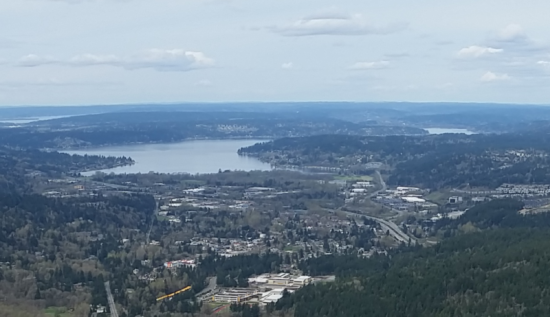Lake Sammamish ‘Warm Water Test Fishery’ Netting Raises Questions
Lee Getzewich had heard that there was some gillnetting going on on Lake Sammamish, a water he’s fished for more than 25 years, and it gave him some pause.
But believing it to be just a “study,” the Issaquah resident decided to hit it earlier this month anyway.
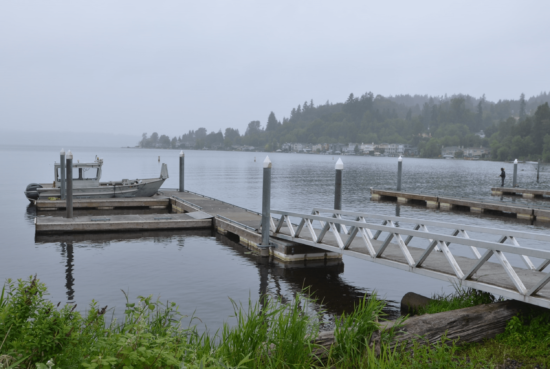
“What we love about it is that it is such a diverse and quality fishery,” Getzewich says of the 4,900-acre King County lake. “We regularly target warmwater species such as bass, crappie, and perch, but we also enjoy the great cutthroat trout fishing, particularly during colder weather.”
When fresh fish is on their menu, yellowbellies and sometimes specks are the target, but that midspring weekday morning, he and his neighbor planned to catch and release cutts and smallies.
“This time of year, when the trout are keying in on the smolts, we regularly catch 20 to 30 cutts in a day, some going over 25 inches,” Getzewich states. “Twenty-seven inches is the biggest I can recall.”
The plan was to cast into the pods of coho just released from the state salmon hatchery in hopes of catching cutthroat preying on the young fish, but after launching at Lake Sammamish State Park’s southeast corner boat ramp they saw nets being deployed off the mouth of Issaquah Creek.

Motoring over to learn more they began talking to the two-person crew. Getzewich says they were shown totes with the previous night’s catch.
“He held up and showed us a sucker fish about 1 pound, but I could see several smallmouth bass and what looked like small crappie in the bin,” Getzewich recalls.
The crew told them that the fish were all being kept so their stomach contents could be studied, and that they were just doing what they’d been told to by biologists.
Getzewich and his neighbor left and fished elsewhere on Sammamish. The day was slow, and they only caught a few small perch and saw some small bass in the shallows at the lake’s north end, where the slough forms.
Afterwards, though, he talked to a buddy with a fisheries degree about what he’d seen and now he isn’t so sure it can be considered a study.
“What I really want to know is, Why is this permitted? Who said this was OK? Why aren’t the people being kept in the loop about this? Where is our DFW?” asks Getzewich. “There is going to be a serious revolution amongst sportsmen if it keeps going.”
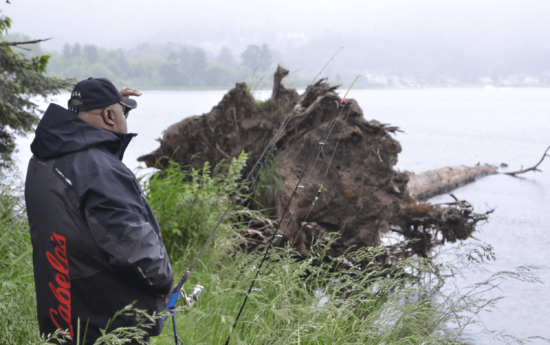
ON A MISTY MAY FRIDAY MORNING I decided to go check out things on Sammamish for myself.
With my luck I figured that if any nets were in the water, they would be halfway down the lake, well out of my smartphone camera’s range, so I grabbed my big Nikon and a telephoto lens and headed for the state park.
I parked at Sunset Beach, near a long row of upturned picnic tables, then wandered out on the trail to the mouth of Issaquah Creek, where a wading angler stood in water midthigh high about 30 yards offshore, casting and retrieving a lure.
With his tackle box back on dry land, he kept a wary eye on what I was up to as I peered into the murk for buoys marking strings of nets, but the only ones to be seen were the floats delineating the swimming area. Over on the other end of the string, an angler sat fishing the edge of the lily pads.
Turning around I went back and struck up a conversation with a plunker set up next to a long since fallen cottonwood. He said he was fishing for cutthroat and as we talked some salmon smolts began breaking the surface of the little bay he was on.
He told me that earlier in the day he’d seen a couple larger fish swim by together, but wasn’t quite sure whether they were trout, bass or something else. More and more of the young fish started jumping and as I zoomed in, there were a couple big swirls among the pod.
The angler didn’t really have anything to say about the netting and seemed more focused on trying to catch the fish making those swirls, so as the mist turned to a light sprinkle I left him to it and drove over to the boat ramp.
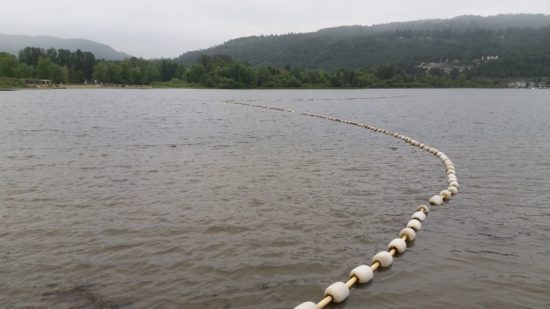
IT’S BEEN A LONG, LONG TIME SINCE I’VE USED this launch, though back when my dad lived in North Bend we’d put in his aluminum boat and fish it somewhat often.
I remember catching a really, really nice trout one time while we were anchored up just to the right of all the ramps. We ate that one as well as some bass we caught another time.
The last time I was on Sammamish was maybe 15 years or so ago with fellow F&H News staffer Jamie Parks. We hit the other southern corner that early spring day to fish for largemouth then zipped north to smallie waters, and on this morning three bassers were launching two boats.
Moored at the end of the leftmost dock was a net boat.
As he readied his craft, I asked the lone angler if he’d heard about the netting and after initially drawing a blank, he recalled fellow anglers mentioning some being dragged through the water.
The other two gents putting in were far more in tune with what’s been going on and they were not exactly happy about it.
As he swiped through pics on his phone of beautiful — and big — bronzebacks, Chris Senyohl, who operates a fly fishing guide service called Intrepid Anglers, told me that the nets had wiped out one of his best smallmouth spots.
His buddy said I’d just missed the net crew and that he’d seen them lift two largemouth out of their boat.
He said they’d been on the water every day during the work week, which is when he said he prefers to fish Sammamish.
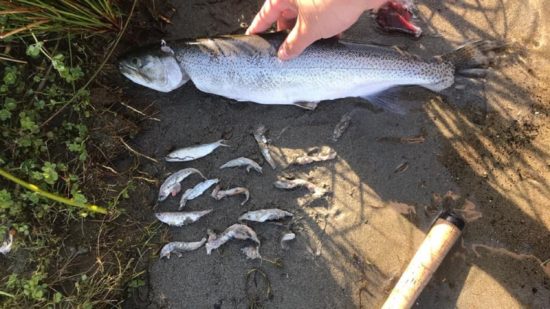
SLIGHTLY DAMP I CALLED IT A MORNING, drove past BMC West, where I worked for awhile after college loading lumber, fighting with customers over bent boards and drawing cartoons at the back gate, and headed in to my office.
I started working on this story on May 9, the day that the Muckleshoot Tribe sent out a notice showing they were intensifying their test fishery for warmwater species on Lake Sammamish and, coincidentally, the day that Lee Getzewich and his neighbor had fished there.
The notice showed that the effort could be expanded from two boats to three, with the maximum number of 3.75- to 6-inch-mesh gillnets tripling, from eight to up to 24.
Now, that doesn’t necessarily mean that that happened, but the regulation restated that the nets could be fished from 6 a.m. Monday until 6 p.m. Friday, by which time they’re to be removed for the weekend.
I left a voice mail on the Muckleshoot Fisheries department’s phone not long afterwards, but it hadn’t been returned as of Tuesday morning, May 28, so to figure out what’s going on, you have to zoom in on a couple different documents.
Probably the most important source of information is inside the LOAF — the 2019-20 List of Agreed Fisheries that was concurred to and signed on April 22 by the Washington Department of Fish and Wildlife and Northwest Indian Fisheries Commission coming out of the annual North of Falcon season-setting process.
The LOAF essentially lays out all of Western Washington’s salmon fisheries in salt- and freshwaters negotiated between the state and 20-plus tribes, and in the back are a number of appendixes.
Pages 83 to 85 detail what is termed the “2019-2020 Warm Water Test Fishery” to collect data whether a directed fishery on spinyrays in the Lake Washington watershed could be “commercially viable” while also avoiding impacts on Endangered Species Act-listed salmon and steelhead.
“Using large mesh gillnets will eliminate impacts on age-0 Chinook and any potential steelhead smolts migrating out to sea,” the project description states.
The Muckleshoots also state they want to “instrument” walleye they catch with acoustic receivers to see how much their range overlaps with outmigrating coho smolts to target those areas in the future.
Another document, the tribe’s 2016 watersheds report, adds context: “A recent tribal study found that fewer than 10% of coho smolts released from the Issaquah Hatchery survived their freshwater migration to Puget Sound. The Lake Washington basin’s miles of docks, bulkheads, rip-rap, warm water, and the many native and exotic fish predators favored by those degraded conditions are likely at fault.”
Their announcement that they were increasing netting efforts roughly coincided with this month’s release of millions of coho as well as Chinook smolts — the fish I saw jumping in the mist.
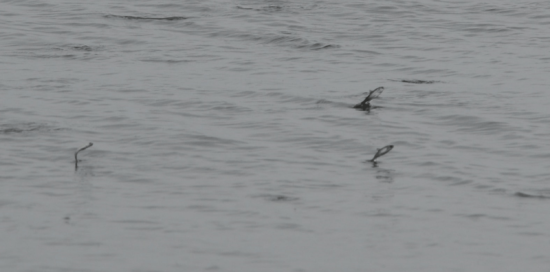
THIS IS THE THIRD YEAR THE MUCKLESHOOT test fishery has been going on — it initially included Lake Washington — and it follows 2015’s unexpected discovery of more than a dozen walleye, including an egg-dripping 13-pound hen and six males close by her.
To paraphrase a retired state fisheries manager, whomever recently put walleye (and then northern pike) in the system was no friend of fellow anglers who’ve chased warmwater species for decades, but the Muckleshoots are more blunt; they use the word “criminal” to describe the act.
Besides its many native stocks, crappie have been in the watershed the longest, in Lake Washington since at least 1890, followed by largemouth in 1918, and smallmouth there and in Sammamish since sometime in the 1960s, perhaps earlier.
Lake Washington is ranked as one of the top 100 bass lakes in the entire country by Bassmaster magazine, and is 16th best in the Western U.S.
Local clubs regularly hit it and according to WDFW tournament fishing records, the average bass landed there during the last 10 years weighed 2.22 pounds; the average on Sammamish was 2.31 pounds.
As popular as they’ve become, the times they are a’changing. The plight of the orcas and their primary food has put a target on the fins of spinyrays.
Earlier this month Gov. Jay Inslee signed Second Substitute House Bill 1579 which primarily — and finally — gives WDFW some actual teeth to protect shoreline habitat for Chinook and their forage fish.
It also contains a clause that the Fish and Wildlife Commission must now “liberalize bag limits for bass, walleye, and channel catfish in all anadromous waters of the state in order to reduce the predation risk to salmon smolts.”
The latter idea came out of the governor’s Southern Resident Orca Task Force’s recommendations last year and it echoes current regulations on the Columbia.
Limits were dropped on the three species in the big river system several years ago following pushing from federal fishery overseers.
How WDFW and the commission interpret “liberalize” and “anadromous” has yet to be determined (no limits? using SalmonScape?), but the bill goes into effect July 1 and will surely include Lakes Sammamish and Washington.
I’m no biologist, but my bet is that bass really don’t have much to fear from sport pursuit because of current support, Northwest anglers’ general preference for other fish on the table and conservation practices, and health advisories.
In other words, it’s a feel-good measure, though with more and more efforts throughout our region to supress or kill off nonnatives like lake trout, northern pike — even rainbow trout — this also feels like it could be a potential inflection point.
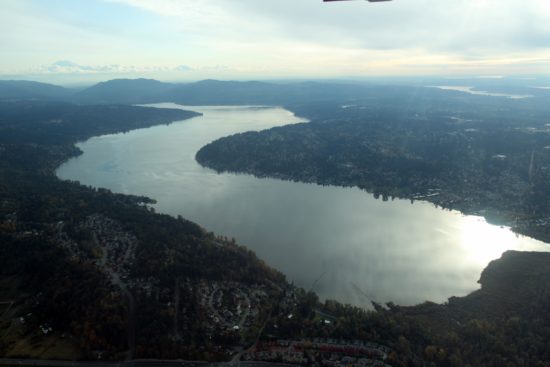
ONE GROUP THAT ESSENTIALLY SUPPORTS the netting on Lake Sammamish is FISH, the Friends of the Issaquah Salmon Hatchery, a nonprofit that leads tours at WDFW’s most-visited production facility and does a lot of youth education with third- and fourth-grade students.
But the organization has also been moving into the realm of advocacy lately, said Larry Franks, its vice president and longtime salmon and steelhead angler.
“We’ve tried to identify things that benefit fish,” he said.
Franks, who retired from Boeing and also has a fisheries degree from the University of Washington, said that despite 2.5 million Chinook being released from the hatchery, last year saw a return of just 1,800 adults, or .07 percent survival.
Part of that is the productivity, or lack thereof, of the North Pacific, as well as harvest by all fleets, but primarily low smolt survival, just 8 to 10 percent from Issaquah to Shilshole Bay, outside the Lake Washington Ship Canal, he said.
“The deck is stacked against them. Our goal is to have better returns,” Franks said.
One problem, he said, is the increasingly narrow band of Lake Sammamish that salmon must swim through between too-warm surface waters and its anoxic depths.
The other is the predators that sit and wait in the zone for the smolts to swim through, then chow down.
Franks believes that the number of warmwater species in the lake and their populations have grown, and that that is impacting salmon outmigration and thus returns that are “dropping precipitously.”
“We’re of the position these are cause and effect, not correlation,” he said.
He acknowledges the growth of the state bass fishery and that smallmouth and largemouth anglers are every bit as dedicated as he is to chasing salmon. He believes that WDFW doesn’t want to piss off spinyray anglers either and is afraid to act — at least without more hard scientific data.
“It comes down to a choice: If you want to retain bass fishing, it’s going to be hopeless, in Larry’s opinion, to save Chinook,” Franks said.
A state staffer close to the situation didn’t want to be quoted for this story, but if official WDFW comments during its recently held Walleye Week on Facebook are any indication, they will be managing salmon and steelhead waters for salmon and steelhead first, and spinyrays where it makes the most sense.
(WDFW is also in the third year of a Lake Washington Ship Canal study to determine abundance and diets of smolt-eating fish there.)
Another option might be trucking Issaquah Hatchery’s smolts and Franks said experiments are ongoing. But anecdotally, it didn’t produce bigger returns last year, though more results are expected this year and next.
That leaves removing the predators, like the Muckleshoots are doing.
“We’re supportive of efforts that would increase the Chinook return,” said Franks.
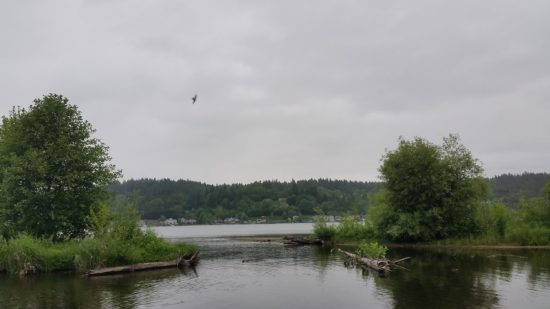
AS FOR HOW MANY FISH ARE BEING GILLNETTED in Sammamish, the LOAF — that marine area by river by lake rundown of agreed-to fishing state and tribal seasons and constraints — contains a short statement that caught my eye.
It says that with “the potential for interaction with the public,” the Muckleshoots propose providing monthly reports on their test fishery, including gear used, where it was fished and for how long, to the National Oceanic and Atmospheric Administration.
So I asked NOAA for that information, and a week and a half later a federal spokesperson provided me with summaries of catches in March and April for what are known as Zones 7 and 8, the northern and southern halves of the lake.
According to the figures, nearly 2,850 fish were caught and removed from the system during those two months, roughly 60 percent of which were native species, 40 percent nonnatives.
Just over 53.5 percent of the overall catch (1,525) was comprised of largescale suckers, a native fish, followed by introduced smallmouth bass (577) at 20 percent and fellow transplant black crappie (258) at 9 percent.
Other species caught include:
Northern pikeminnow (146), 5 percent, native
Brown bullhead (126), 4 percent, nonnative
Cutthroat trout (85), 3 percent, native
Largemouth bass (78), 3 percent, nonnative
Peamouth chub (24), 1 percent, native
Common carp (11), .4 percent, nonnative
Yellow perch (10), .3 percent, nonnative
Hatchery-origin Chinook (3), .1 percent, native
Mountain whitefish (3), .1 percent, native
Hatchery-origin coho (1), .03 percent, native
Rock bass (1), .03 percent, nonnative
Walleye (1), .03 percent, nonnative
No rainbow trout or natural-origin Chinook were caught, NOAA’s catch breakout shows.
Kokanee, which are at low levels in the lake but also a pelagic, or open-water, fish were not listed in the catch tally.
Under the terms of the test fishery, if three wild steelhead are netted, the effort will be shut down immediately. In the LOAF, the Muckleshoots state that there is a “very low to zero” chance of any turning up, and if one did, they suggest it would probably be a Green River stray.
Gillnetting is set to run through June 15, and I am interested to see what turns up in the catch during the final seven weeks of the program, what with the release of all those coho and Chinook smolts into the system — will the catch percentages change?
The test fishery is also scheduled to resume next January through April.
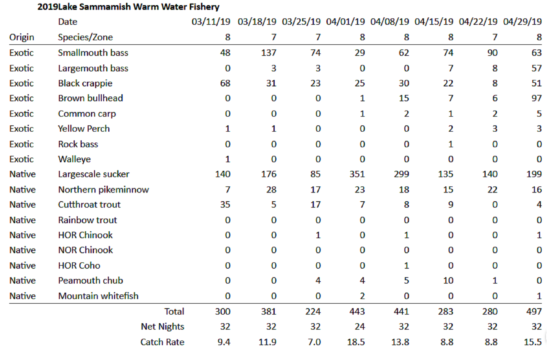
SOMETHING LARRY FRANKS SAID STUCK WITH me after our talk:
“It’s a thorny problem.”
Understatement of the century.
As a salmon angler, like many other Northwest sportsmen these days I’m howling that something, anything needs to be done about predators — be they sea lions, harbor seals, Caspian terns, cormorants or piscivorous fish — to get more smolts out and more adult fish back.
That means there’s no way I can support killing pikeminnows in the Columbia, northern pike everywhere in our region, birds at the mouth of the river, and pinnipeds at Bonneville and Willamette Falls without also giving the thumbs up to removing smolt-eating fish in Lake Sammamish.
At the same time, my inner spinyray angler is revolted by what feels like a targeted attack on a fish I like — I literally nearly went bankrupt trying to write a story inspired by catching a huge smallmouth on the Grande Ronde — one that’s widespread across the Northwest and is a great entry-level fish that’s easy to catch.
I’m all for hatcheries, but, holy sh*t, here’s a species that doesn’t require the world’s largest fish production infrastructure to perpetuate in perpetuity, plus they’re ready-made for climate change.
Yet as a Washington native, tell me why our fisheries have to be exactly like what you can already find in Michigan, Arkansas, Pennsylvania, Ohio, Quebec, Tennessee, Iowa, New Jersey, Minnesota, New York, Ontario, Missouri, the Dakotas, New England, Illinois, Wisconsin, Indiana? We’re not the Old Northwest, this is the Pacific Northwest, home of silver fish, not green ones, and proud of it.
Then again, I’ve also read my King of Fish: The Thousand Year Run of Salmon — with all the problems that our kings, silvers and steelies face, you tell me that smallies and their Midwestern and Southern cousins aren’t what’s going to come out of the other end of things here as the sole survivors.
The utter mess we have made of this region obliges us to do our best to fix it.
At what cost, pray tell?
So as you can tell, I’ve got mostly mixed feelings here.
I do, however, have a problem with the illegal release of walleye in Lakes Sammamish and Washington, and northern pike in the latter. Doing so was among the most asinine, destructive and disrespectful things perpetrated on the watershed since the Great Glacier smothered it. I’ll tar and feather the a@$hole bucket biologist(s) myself.
The comanagers aren’t talking, but I’ll tell you what, I wouldn’t doubt for a second that those crimes were among the tipping points that set their test fisheries in motion. And now everybody but the guilty are paying.
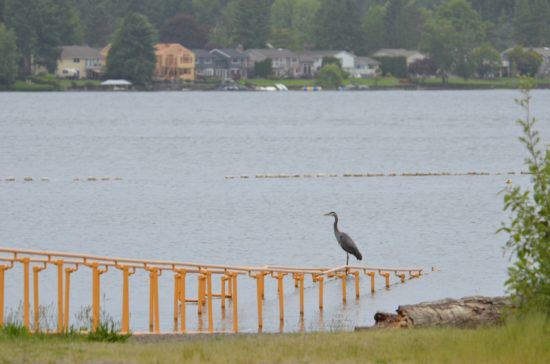
I’M DOUBTFUL THERE WILL BE A “COMMERCIALLY VIABLE” fishery for bass in Lake Sammamish or elsewhere in the system some day, but I could be wrong.
I just hope that the netting shows whether targeted removals of smolt predators at select times and places is worthwhile for increasing salmon survival and expanding harvest seasons — while also preserving native and nonnative fish and fisheries that aren’t going away any time soon.
I’m willing to put a nickel down that while introduced exotics like the bass do have an impact, it’s mostly limited to the two months or so that the young coho and Chinook are transiting the system, and that like over on Lake Washington with sockeye smolts, cutthroat and northern pikeminnow are the actual primary predators.
Again, I could be wrong, but I’d love to learn what is in the stomachs of the thousands of fish the Muckleshoots pull out of the lake this spring. I’d hate to see this all go to waste.
